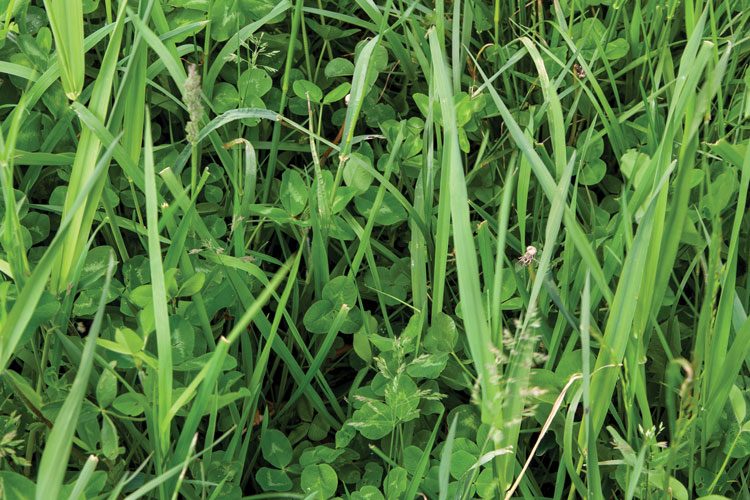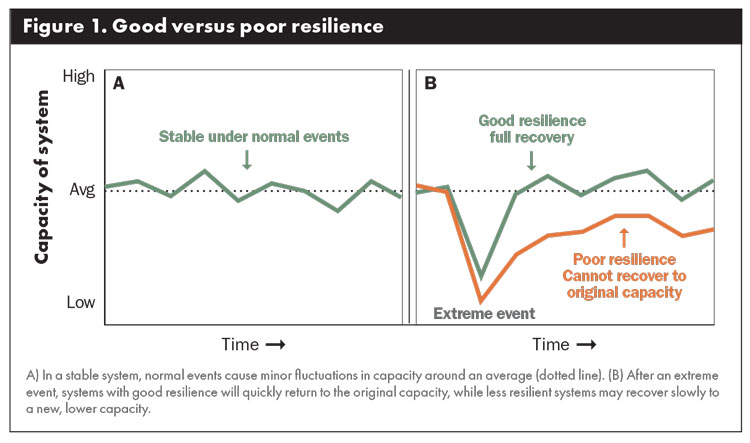The author is an extension forage and cover crop specialist with Michigan State University.

Resilience is a word that is often bandied around, but what exactly does it mean in relation to agriculture and forages? The Oxford Dictionary defines resilience as the “capacity to withstand or to recover quickly from difficulties.”
We can probably all agree that forage growers face no end of difficulties even in “normal” times and are used to dealing with challenges, often involving all kinds of weather at all the wrong times. However, resilience is about more than dealing with these ordinary challenges. Extreme events are truly becoming more extreme and ever more frequent, and these can have long-lasting implications for operations that are not prepared for them.
Stable is not resilient
We always strive for stability in our farming systems, but stability is not the same thing as resilience. Figure 1 illustrates the differences among stable systems and those with good or poor resilience. In an agricultural context, stability is defined as the ability to maintain function with only minor variations in capacity when challenged with “normal” events. An example is the recovery of pasture productivity after an ordinary summer slump caused by an expected seasonal dry spell or other normal weather variations. This is represented in the left graph panel where system performance varies up or down as conditions change but generally sticks close to the average.

Resilience is shown in the right panel of Figure 1 after system capacity is challenged by some extreme event. A forage-related example would be pasture recovery after a 100-year drought. Capacity of the resilient system will crash in immediate response to the event, but once the event is over, it can then recover quickly to the original level. On the other hand, the system with poor resilience may crash farther, recover more slowly, and never regain its original performance.
Recognize that the concepts of stability and resilience apply best to whole systems, whether man-made or natural, and not to single pieces. Human nature makes it easy to get tunnel vision and pay too much attention to a single thing and miss the fact that the bottom is falling out somewhere else entirely. For example, farmers may be focused on the effect of drought on their own pastures and not be aware that a widespread drought may also affect things like seed availability if forage seed crops fail or fertilizer supplies if river shipping is impacted by low water levels.
In a forage context, the pieces of an agricultural system include the natural resources that are available on a particular farm such as acreage, soil, water, weather, and climate; the resources available to the farmer such as equipment, infrastructure, financing, labor, time, purchased inputs, and opportunities to learn; market factors such as sales outlets, prices, and consumer preferences; social factors such as family concerns, quality of life, and public perception; and regulatory factors on local, state, and national levels. These things are all so thoroughly entwined with each other that it is rarely possible to change one without impacting something else, often in an unexpected way.
In the face of all these complexities, we may hear the phrase “business as usual.” This is often interpreted with a negative bias, but all it really means is that normal practices continue without change. This is not necessarily a bad thing if the system is stable, meeting needs, and nothing unusual is happening to disrupt it. The problem happens if conditions change and practices do not change to adapt, setting things up for issues when an extreme event inevitably happens.
Inherent forage resilience
One way to reduce severe consequences resulting from disasters is to raise the baseline for normal capacity by changing practices proactively before the disaster strikes. Forage crops provide a rare opportunity to do this and actually improve resilience of agricultural systems. There are three features of forage crops that are useful in helping raise the baseline for resilience.
The first is biodiversity. Research clearly shows that enhancing biodiversity increases the productivity, stability, and resilience of agricultural systems. Biodiversity does not need to include complicated forage mixtures or rotations. At its most basic level, it simply means growing more than one plant or animal species, either at the same time, such as a mixed grass/legume hayfield, or in sequence, such as including alfalfa in a crop rotation or following grazing cattle with pastured poultry. If wisely chosen to meet farm goals, mixtures or rotations as simple as two species can provide benefits over growing a single crop.
Forages, especially pastures, are already commonly grown in deliberate mixtures of compatible grasses and legumes in order to buffer seasonal forage availability, raise the quality of animal diets, and improve forage yield. These mixtures also provide the diverse roots that help create the vibrant community of soil microbes and underground life needed for healthy soil. Aboveground, forages also support healthy populations of pollinator insects as well as other beneficial insects that can help reduce pest problems in neighboring crops and rotations.
The second important feature is perenniality. Perennial forages live for many years, reducing the need for establishment disturbances. Research has shown that these species often have greater capacity to improve soil, protect water, and sequester carbon than annual crops do, even if the perennial is only grown as part of a rotation. The extensive and undisturbed nature of perennial root systems enhances their value for soil improvement. Better soil health typically improves resilience.
Waste not, want not
The third important factor is circularity (Figure 2). The concept of linear versus circular systems was first used in the context of economics, but it can be applied to any system that uses resources. Linear systems are based on the consumption of new resources for each production cycle. Resources that are not fully used during production, distribution, and consumption of the product do not re-enter the cycle and instead become a liability as waste products that need costly disposal somewhere along the line.

In contrast, a circular system uses the concepts of reuse, repair, and recycle to turn waste products back into the production process as an asset. This greatly reduces both the amount of new resources needed and the cost of waste disposal.
One classic example of circularity is inclusion of livestock in cropping systems where feeding livestock can add value to grain crops and convert forage rotations, cover crops, or crop residue into valuable manure nutrients that are put back into the farm to support plant growth and reduce the need for chemical fertilizers. Legume-grass forage mixtures are another example where the legume can provide most of the nitrogen needed by its grass companion and also provide nutrients for subsequent crops in a rotation while reducing the need for purchased fertilizer.
Alfalfa rotations routinely fix enough nitrogen to supply the entire requirement for a subsequent corn crop. Partial benefits from an alfalfa rotation may last as long as five years after the alfalfa rotation ends. Some forage crops, such as alfalfa, chicory, and brassicas, are able to improve phosphorus availability in soils and thus also reduce the need for phosphorus fertilizer. This will likely become even more important in the future because world supplies of rock phosphate, the source of most phosphorus fertilizers, are limited.
In order to build resilience, we need to learn more about how it develops. The Ag Resilience Project is a collaboration among researchers, nonprofit organizations, and commodity groups across the U.S. One very important part of the project is building a volunteer farmer network encompassing all types of farming systems to help learn what makes a farming system resilient to today’s challenges. We expect that forages will play a large role.
The project will be using online surveys and interviews to learn about farming practices and decision-making processes that enhance or impede resilience in U.S. farming systems. If you are interested in learning more about participating as one of our volunteers, please contact the author at cassida@msu.edu.
This article appeared in the April/May 2023 issue of Hay & Forage Grower on page 14-15.
Not a subscriber? Click to get the print magazine.

